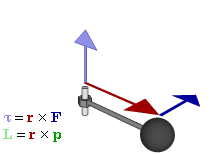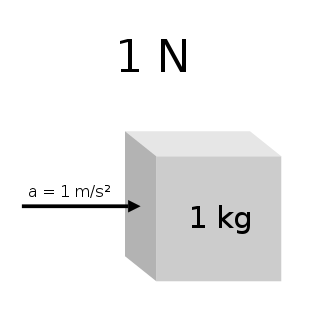Conversion of units is the conversion of the unit of measurement in which a quantity is expressed, typically through a multiplicative conversion factor that changes the unit without changing the quantity. This is also often loosely taken to include replacement of a quantity with a corresponding quantity that describes the same physical property.
In physics, an electronvolt, also written electron-volt and electron volt, is the measure of an amount of kinetic energy gained by a single electron accelerating through an electric potential difference of one volt in vacuum. When used as a unit of energy, the numerical value of 1 eV in joules is equal to the numerical value of the charge of an electron in coulombs. Under the 2019 revision of the SI, this sets 1 eV equal to the exact value 1.602176634×10−19 J.

Horsepower (hp) is a unit of measurement of power, or the rate at which work is done, usually in reference to the output of engines or motors. There are many different standards and types of horsepower. Two common definitions used today are the imperial horsepower as in "hp" or "bhp" which is about 745.7 watts, and the metric horsepower as in "cv" or "PS" which is approximately 735.5 watts.

In physics, the kinetic energy of an object is the form of energy that it possesses due to its motion.

Pressure is the force applied perpendicular to the surface of an object per unit area over which that force is distributed. Gauge pressure is the pressure relative to the ambient pressure.
Power is the amount of energy transferred or converted per unit time. In the International System of Units, the unit of power is the watt, equal to one joule per second. Power is a scalar quantity.

In physics and mechanics, torque is the rotational analogue of linear force. It is also referred to as the moment of force. The symbol for torque is typically , the lowercase Greek letter tau. When being referred to as moment of force, it is commonly denoted by M. Just as a linear force is a push or a pull applied to a body, a torque can be thought of as a twist applied to an object with respect to a chosen point; for example, driving a screw uses torque, which is applied by the screwdriver rotating around its axis. A force of three newtons applied two metres from the fulcrum, for example, exerts the same torque as a force of one newton applied six metres from the fulcrum.
Specific impulse is a measure of how efficiently a reaction mass engine, such as a rocket using propellant or a jet engine using fuel, generates thrust.

The newton is the unit of force in the International System of Units (SI). It is defined as , the force which gives a mass of 1 kilogram an acceleration of 1 metre per second squared.

In science, work is the energy transferred to or from an object via the application of force along a displacement. In its simplest form, for a constant force aligned with the direction of motion, the work equals the product of the force strength and the distance traveled. A force is said to do positive work if it has a component in the direction of the displacement of the point of application. A force does negative work if it has a component opposite to the direction of the displacement at the point of application of the force.
The pound of force or pound-force is a unit of force used in some systems of measurement, including English Engineering units and the foot–pound–second system.
The poundal is a unit of force, introduced in 1877, that is part of the Absolute English system of units, which itself is a coherent subsystem of the foot–pound–second system.
The slug is a derived unit of mass in a weight-based system of measures, most notably within the British Imperial measurement system and the United States customary measures system. Systems of measure either define mass and derive a force unit or define a base force and derive a mass unit. A slug is defined as a mass that is accelerated by 1 ft/s2 when a net force of one pound (lbf) is exerted on it.

A dynamometer car is a railroad maintenance of way car used for measuring various aspects of a locomotive's performance. Measurements include tractive effort, power, top speed, etc.
The foot–pound–second system is a system of units built on three fundamental units: the foot for length, the (avoirdupois) pound for either mass or force, and the second for time.
Free recoil / Frecoil is a vernacular term or jargon for recoil energy of a firearm not supported from behind. Free recoil denotes the translational kinetic energy (Et) imparted to the shooter of a small arm when discharged and is expressed in joules (J), or foot-pound force (ft·lbf) for non-SI units of measure. More generally, the term refers to the recoil of a free-standing firearm, in contrast to a firearm securely bolted to or braced by a massive mount or wall. Free recoil should not be confused with recoil:

Sectional density is the ratio of an object's mass to its cross sectional area with respect to a given axis. It conveys how well an object's mass is distributed to overcome resistance along that axis.

The pound per square inch or, more accurately, pound-force per square inch, is a unit of measurement of pressure or of stress based on avoirdupois units. It is the pressure resulting from a force with magnitude of one pound-force applied to an area of one square inch. In SI units, 1 psi is approximately 6,895 pascals.
Some fields of engineering in the United States use a system of measurement of physical quantities known as the English Engineering Units. Despite its name, the system is based on United States customary units of measure.

A coherent system of units is a system of units of measurement used to express physical quantities that are defined in such a way that the equations relating the numerical values expressed in the units of the system have exactly the same form, including numerical factors, as the corresponding equations directly relating the quantities. It is a system in which every quantity has a unique unit, or one that does not use conversion factors.















